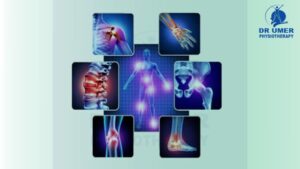Osteoarthritis (OA) is a prevalent degenerative joint disease that affects millions of people worldwide, causing pain, stiffness, and reduced mobility. In the comprehensive management of OA, physiotherapists play a pivotal role in providing effective treatment and improving the quality of life for individuals living with this condition.

What is Osteoarthritis?
Osteoarthritis is characterized by the breakdown of cartilage in the joints, leading to pain, inflammation, and functional limitations. It commonly affects weight-bearing joints such as the knees, hips, and spine, although it can also impact other joints in the body.
The Role of Physiotherapists
Physiotherapists are highly trained healthcare professionals specializing in musculoskeletal conditions like osteoarthritis. They employ a variety of evidence-based techniques to alleviate pain, improve joint function, and enhance overall mobility in patients with OA.
1. Pain Management:
One of the primary objectives of physiotherapy in osteoarthritis management is pain relief. Physiotherapists use modalities such as heat therapy, cold therapy, ultrasound, and transcutaneous electrical nerve stimulation (TENS) to reduce pain and discomfort in affected joints. Additionally, manual therapy techniques like joint mobilization and soft tissue massage can help alleviate muscle tension and stiffness, providing symptomatic relief.
2. Exercise Prescription:
Exercise is a cornerstone of osteoarthritis management, and physiotherapists prescribe tailored exercise programs to improve joint flexibility, strength, and stability. Range-of-motion exercises help maintain or restore joint mobility, while strengthening exercises target the muscles surrounding the affected joints, providing support and reducing strain. Aerobic exercises such as walking, swimming, and cycling promote cardiovascular health and weight management, crucial factors in managing osteoarthritis effectively.
3. Education and Self-Management:
Empowering patients with knowledge about their condition and self-management strategies is another essential aspect of physiotherapy intervention. Physiotherapists educate patients about joint protection techniques, ergonomic principles, and lifestyle modifications to minimize pain and optimize function in daily activities. By teaching proper body mechanics and ergonomic principles, physiotherapists empower patients to prevent exacerbations and manage symptoms proactively.
4. Assistive Devices and Orthotics:
In some cases, physiotherapists may recommend the use of assistive devices or orthotic interventions to support joint function and alleviate pain. Custom orthotics, braces, splints, and walking aids can provide stability, reduce joint stress, and improve mobility, enabling individuals with osteoarthritis to engage in daily activities with greater ease and comfort.
5. Functional Rehabilitation:
Functional rehabilitation focuses on enhancing the individual’s ability to perform specific tasks and activities essential for daily living. Physiotherapists assess functional limitations and design rehabilitation programs tailored to each patient’s unique needs and goals. Through targeted exercises and functional training, patients learn adaptive strategies and regain independence in activities such as walking, climbing stairs, and getting in and out of chairs.
Conclusion:
In conclusion, physiotherapists play a crucial role in the multidisciplinary management of osteoarthritis, providing comprehensive care aimed at reducing pain, improving joint function, and enhancing the overall quality of life for patients. By employing evidence-based interventions and personalized treatment approaches, physiotherapists empower individuals with osteoarthritis to lead active, fulfilling lives despite the challenges posed by this chronic condition.
By incorporating the expertise of physiotherapists into osteoarthritis management plans, individuals can experience significant improvements in pain relief, mobility, and overall well-being, enabling them to live life to the fullest despite the challenges posed by osteoarthritis.
Share this post: on Twitter on Facebook


